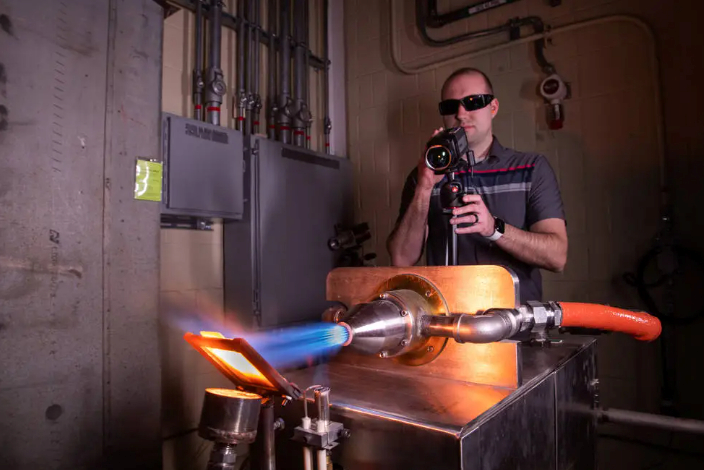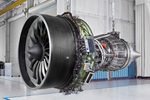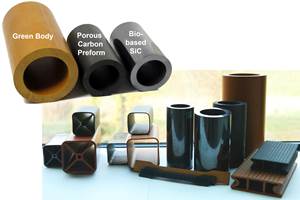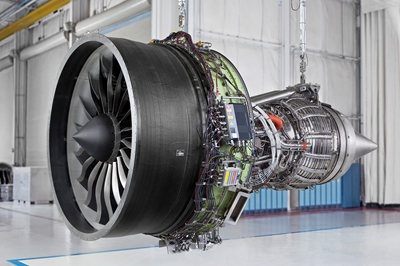GE Aerospace awarded demonstration contract for NASA HyTEC project
Turbofan engine small core technology development with CMC-coated components targets enhanced fuel efficiency in single-aisle aircraft by mid-2030s.

Michael Presby, a research materials engineer at NASA’s Glenn Research Center in Cleveland, adjusts an infrared thermal imaging camera used to monitor the temperature profile of a NASA-developed, high-temperature environmental barrier coating deposited on a CMC in support of the agency’s HyTEC project. The composite’s environmental barrier coating surface temperature is 3,000ºF. Photo Credit: NASA/Bridget Caswell
NASA (Washington, D.C., U.S.) has selected GE Aerospace (Cincinnati, Ohio, U.S.) to work with the agency’s Hybrid Thermally Efficient Core (HyTEC) project, which is aiming to develop more fuel-efficient engines for single-aisle aircraft. As part of the project, HyTEC will be implementing ceramic matrix composite (CMC) materials in some engine components with environmental barrier coatings.
The HyTEC’s Phase 2 Integrated Core Technology Demonstration is a cost-sharing contract with a maximum value of approximately $68.1 million and a 5-year performance period that begins Feb. 15, 2024. The contract is awarded with a 50% minimum GE Aerospace cost share during the contract period.
Part of NASA’s Advanced Air Vehicles program, HyTEC was established in June 2021 to accelerate the development of turbofan engine small core technologies. The project also includes work on hybridization — developing methods to pull more electrical power from this engine to power other systems aboard the aircraft, which could increase fuel efficiency in much the same way a hybrid car does. In a 2022 article on the subject, Anthony Nerone, who leads the HyTEC project from NASA’s Glenn Research Center in Cleveland, said that “with the small-core engine in specific, we are targeting a 5-10% fuel burn reduction,” though he notes that, combined with other initiatives, this estimation could increase.

This cross-section of a turbofan jet engine shows the components of the HyTEC project’s smaller engine core, with the compressor, combustor, and turbine noted. By shrinking the engine core, better fuel efficiency can be achieved. Photo Credit: NASA
The first phase of the project focused on developing several key engine core technologies, including high-pressure compressors, high-pressure turbines, advanced materials, electric hybridization and compact combustors, through subsystem or component tests. To meet the goal of HyTEC Phase 2, GE Aerospace will integrate these technologies into an engine core to perform a compact, high-power density core ground demonstration by the end of September 2028. This next step is in line with NASA’s plan to “collaborate with engine companies to make small-core technologies available much sooner than planned … for use in aviation fleets around the mid-2030s.”
Related Content
Developing milling for CMC because grinding takes too long
Economical processes that can cut machining time by 70% are being tested on aeroengine turbine blade demonstrators by Hufschmied and DLR in the SCANCUT project.
Read MoreBombardier begins manufacture of Global 8000 business jet
Ultra-long range business jet featuring CMC-intensive engine and a range of 8,000 nautical miles is set to enter service in second half of 2025 as it remains on track for flight testing.
Read MoreBio-based SiC ceramics from wood polymer composites
Austrian research institute Wood K plus makes 95% silicon carbide ceramics more sustainable (>85% bio/recycled content), enables 3D shapes via extrusion, injection molding and 3D printing.
Read MoreMATECH’s FAST technology achieves ultra-high density C/C composites
Targeting demanding hypersonic missile applications and ballistic reentry, the patent-pending process increases C/C composite ablation and oxidation resistance by 20 times.
Read MoreRead Next
Airbus, CFM International collaborate on hydrogen combustion technology
A380 flying testbed will be equipped with liquid hydrogen (LH2) tanks and modified turbofan engine to take flight around the middle of this decade.
Read MoreGKN enhances aeroengine agreement with GE Aerospace
Extended deal sees new tech development and implementation for the GEnx, increased engine fan case supply and GKN’s addition to the repair network.
Read MoreNASA moves into next phase of high-speed supersonic travel project
Under the Advanced Air Vehicle’s Program, Boeing- and Northrop Grumman-led teams are charged with developing technology roadmaps with vehicle concepts that can operate at Mach 2+ speeds.
Read More










.jpg;maxWidth=300;quality=90)












